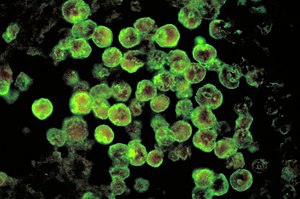Naegleriasis (also known as primary amoebic meningoencephalitis; PAM) is an almost invariably fatal infection of the brain by the free-living unicellulareukaryote Naegleria fowleri. Symptoms are meningitis-like and include headache, fever, nausea, vomiting, a stiff neck, confusion, hallucinations and seizures.[5] Symptoms progress rapidly over around five days, and death usually results within one to two weeks of symptoms.[5][6]
N. fowleri is typically found in warm bodies of fresh water, such as ponds, lakes, rivers and hot springs. It is also found in an amoeboid or temporary flagellate stage in soil, poorly maintained municipal water supplies, water heaters, near warm-water discharges of industrial plants and in poorly chlorinated or unchlorinated swimming pools. There is no evidence of it living in salt water. As the disease is rare, it is often not considered during diagnosis.
Although infection occurs very rarely,[6] it almost inevitably results in death.[7][8] Of the 450 or so naegleriasis cases in the past 60 years, only seven have survived,[9] for a case fatality rate of 98.5%.
| Naegleriasis | |
|---|---|
| Other names | Primary amoebic meningoencephalitis (PAM), amoebic encephalitis, naegleria infection, amoebic meningitis |
 | |
| Histopathology of primary amoebic meningoencephalitis due to Naegleria fowleri. Direct fluorescent antibodystain. | |
https://en.wikipedia.org/wiki/Naegleriasis
Dioctophyme renale, commonly referred to as the giant kidney worm[1][2][3] is a parasitic nematode (roundworm) whose mature form is found in the kidneys of mammals. D. renaleis distributed worldwide, but is less common in Africa and Oceania.[4] It affects fish eating mammals, particularly mink [1] and dogs.[4] Human infestation is rare, but results in kidney destruction, usually of one kidney and hence not fatal. A 2019 review listed a total of 37 known human cases of dioctophymiasis in 10 countries with the highest number (22) in China. Upon diagnosis through tissue sampling, the only treatment is surgical excision.[5]
| Dioctophyme renale | |
|---|---|
 | |
| Dioctophyme renale that was free floating in the abdomen of a dog |
https://en.wikipedia.org/wiki/Dioctophyme_renale
No comments:
Post a Comment